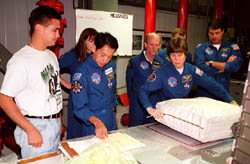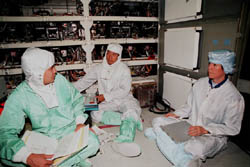
| Astronaut Mohri's Training Report (3) |
 |
 |
 |

Mission Control Center |
Joint Integrated Simulation
On July 1, 1999, a Joint Integrated Simulation (JIS) was held at Johnson
Space Center (JSC) in preparation for mission STS-99. A JIS is the largest
scale simulation of mission operations that are conducted. JSC flight controllers
sit in the actual mission control center, and engineers and researchers
from the Jet Propulsion Laboratory (JPL) in California sit in the payload
operations control center which provides operational control for the experiments
on board the Space Shuttle. The mission STS-99 crew, including astronaut
Mohri, sit in the Shuttle Mission Simulator which is almost identical to
a real Space Shuttle. Flight controllers and the crew operate according
to the shift plan of the mission.
This simulation simulates activities from two hours after the launch to
24 hours form that point. During this period, the 60m mast is extended
and the first mapping (data collection for generating a map) is conducted.
During an ordinary JIS, the instructor team intentionally generates many
problems to train the crew for each of the cases. However, since this simulation
is the first JIS, a smooth mast extension was scheduled. Aided by computer
graphic images and data which is generated by a simulator, crew members
and controllers can be trained as if they are operating actual equipment.
As the launch approaches, more JISs occur.
Payload Operation
Astronaut Mohri is continuing to train on SRTM operation, which is his
primary on-orbit task. Using a payload trainer at JSC, crew members receive
training on operating the SRTM antenna and system monitoring equipment
such as operation panels and lap top computers. Astronaut Mohri received
some training on July 14, together with astronauts Janice Voss and Dominic
L. Gorie, who are on the same shift. During this training, instructors
intentionally generate trouble cases. Referring to the procedure, astronauts
determine the causes of the problem and execute the necessary procedures.
Most astronaut training is composed of such unscheduled procedures.
Crew Equipment Interface Test (CEIT)
On July 28, the Crew Equipment Interface Test (CEIT) was conducted at NASA
Kennedy Space Center (KSC). This test was conducted in Space Shuttle Endeavour
after it was prepared for the mission, and many items were confirmed based
on what they learned in the training or on the contents of the procedures.
These included any problems or inconveniences remaining in the equipment
and any remaining discrepancies. Tools to be used in case of troubles as
well as the toilet and beds necessary for life in space were checked as
well. In August, Space Shuttle Endeavour will be connected to the external
tank and solid rocket boosters, and rolled out to Pad 39A for launch.

Astronaut Mohri and STS-99 crew members checking
equipment called the "Window Shade Bag." |

Astronauts Mohri and Voss and a JSC engineer checking equipment
inside Endeavour. Equipment can be seen since the middeck lockers were
not installed yet. |
The next training report will be issued in early September.
Last Updated : Aug. 17, 1999
|
